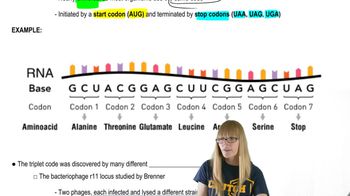The DNA sequences shown below are from the promoter regions of six bacterial genes. In each case, the last nucleotide in the sequence (highlighted in blue) is the nucleotide that initiates transcription. Examine these sequences and identify the Pribnow box sequence at approximately -10 for each promoter.
Table of contents
- 1. Introduction to Genetics51m
- 2. Mendel's Laws of Inheritance3h 37m
- 3. Extensions to Mendelian Inheritance2h 41m
- 4. Genetic Mapping and Linkage2h 28m
- 5. Genetics of Bacteria and Viruses1h 21m
- 6. Chromosomal Variation1h 48m
- 7. DNA and Chromosome Structure56m
- 8. DNA Replication1h 10m
- 9. Mitosis and Meiosis1h 34m
- 10. Transcription1h 0m
- 11. Translation58m
- 12. Gene Regulation in Prokaryotes1h 19m
- 13. Gene Regulation in Eukaryotes44m
- 14. Genetic Control of Development44m
- 15. Genomes and Genomics1h 50m
- 16. Transposable Elements47m
- 17. Mutation, Repair, and Recombination1h 6m
- 18. Molecular Genetic Tools19m
- 19. Cancer Genetics29m
- 20. Quantitative Genetics1h 26m
- 21. Population Genetics50m
- 22. Evolutionary Genetics29m
10. Transcription
Transcription in Eukaryotes
Problem 14
Textbook Question
Three genes identified in the diagram as A, B, and C are transcribed from a region of DNA. The 5'-to-3' transcription of genes A and C elongates mRNA in the right-to-left direction, and transcription of gene B elongates mRNA in the left-to-right direction. For each gene, identify the coding strand by designating it as an 'upper strand' or 'lower strand' in the diagram.

 Verified step by step guidance
Verified step by step guidance1
Understand the concept of transcription: During transcription, the RNA polymerase reads the template strand of DNA in the 3'-to-5' direction to synthesize mRNA in the 5'-to-3' direction. The coding strand is the DNA strand that has the same sequence as the mRNA (except that thymine is replaced by uracil in RNA).
Analyze the direction of transcription for each gene: For genes A and C, transcription elongates mRNA in the right-to-left direction. For gene B, transcription elongates mRNA in the left-to-right direction.
Determine the template strand for each gene: The template strand is complementary to the mRNA strand. For genes A and C, since transcription occurs right-to-left, the lower strand must be the template strand. For gene B, since transcription occurs left-to-right, the upper strand must be the template strand.
Identify the coding strand for each gene: The coding strand is the strand opposite to the template strand. For genes A and C, the upper strand is the coding strand because the lower strand is the template strand. For gene B, the lower strand is the coding strand because the upper strand is the template strand.
Summarize the results: For gene A, the coding strand is the upper strand. For gene B, the coding strand is the lower strand. For gene C, the coding strand is the upper strand.
 Verified video answer for a similar problem:
Verified video answer for a similar problem:This video solution was recommended by our tutors as helpful for the problem above
Video duration:
1mPlay a video:
Was this helpful?
Key Concepts
Here are the essential concepts you must grasp in order to answer the question correctly.
Transcription Directionality
Transcription directionality refers to the orientation in which RNA polymerase synthesizes mRNA from a DNA template. In eukaryotic cells, transcription occurs in the 5'-to-3' direction, meaning that nucleotides are added to the 3' end of the growing mRNA strand. This directionality is crucial for understanding which DNA strand serves as the template and how the resulting mRNA aligns with the coding sequence.
Recommended video:
Guided course

Eukaryotic Transcription
Coding and Template Strands
In the context of DNA transcription, the coding strand (also known as the sense strand) has the same sequence as the mRNA (except for uracil replacing thymine), while the template strand (antisense strand) is complementary to the mRNA. Identifying which strand is the coding strand is essential for determining the correct sequence of the mRNA produced during transcription, as it dictates the protein-coding potential of the gene.
Recommended video:
Guided course

The Genetic Code
Gene Orientation
Gene orientation refers to the arrangement of genes on a DNA molecule, which can be oriented in either direction. This orientation affects how transcription occurs, as genes can be transcribed from either the upper or lower strand of the DNA. Understanding gene orientation is vital for correctly identifying which strand corresponds to each gene's transcription direction, as seen in the question regarding genes A, B, and C.
Recommended video:
Guided course

Mapping Genes

 9:16m
9:16mWatch next
Master Eukaryotic Transcription with a bite sized video explanation from Kylia
Start learningRelated Videos
Related Practice
Textbook Question
545
views
